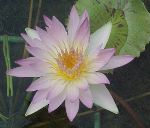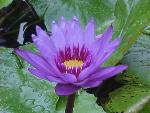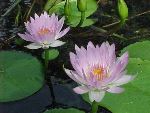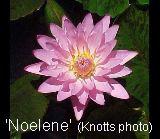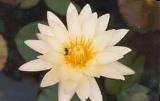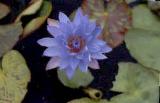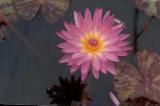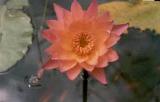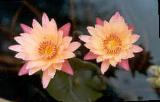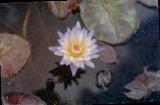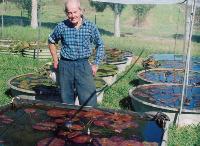 |
Text & photos provided by Noelene Pullen Click images to enlarge |
|
| Charlie began hybridizing shortly afterwards crossing 'Blue Capensis' with the imported ones. In 1954 'Noelene', a lavender pink, was his first recognized breakthrough using 'Golden West' and 'Blue Capensis' as parents. After a few years, Charlie came to realise that using a species like 'Blue Capensis'meant that the blue colour dominated and therefore was not a good seed parent. He decided to only cross the imported tropicals and their progeny. Unfortunately, there wasn't much time for his hobby whilst trying to earn a living raising and selling goldfish and water plants as well as his two daughters, Noelene and Margaret. | ||
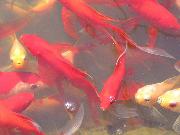 Detailed article about Charlie's fish |
However, Dad's interest in improving species has also been evident in goldfish breeding, particularly the Comet variety, as he was keen to increase his turnover by selling goldfish at a younger age and size. When Charlie first bred fish in the early 1930s it took from one to three years for goldfish to change colour from brown to gold. By the 1950s all his young fish turned red from six weeks to twelve months due to twenty years of selective breeding from fish that turned gold more quickly. As years went by, the fish produced were closer to red than gold. Charlie gained a reputation in Australia for breeding the deepest coloured Comets. | |
| In the 1960s Evan Williams, from northern New South Wales, became interested in waterlilies. Edie Metelik (a long time friend) of Austral Watergardens in outer Sydney, referred Evan to my father for specialist information. Charlie, living in Sydney, then became involved with the quarantine of Evan's imported new tropicals from the United.States. Evan then began exporting some of Charlie's hybrids to America. During the 1970s Dad acquired white 'Ted Uber' which he used as a seed parent to produce new hybrids such as 'White Delight', 'White Fleck', 'Charles Winch', and 'Mark Pullen'. Other new imports he obtained and used in hybridizing included 'Yellow Dazzler', 'Afterglow', and 'Blue Triumph'. | ||
|
||||||||
 1. Cover parent buds with floating mesh or mosquito net before they are due to open to keep out the bees |
In 1978 Charlie retired from full-time work and decided to devote the rest of his years to his hobby of hybridizing day-flowering tropical waterlilies. By this time he was building his ponds from plastic sheeting which was later replaced by butyl rubber. This meant that quicker results could be achieved as the ponds didn't need to be cured like those made from cement. Due to suburban sprawl and Dad's need for a large backyard, the family helped him move a few times over the years, the last being in 1989 to a 2.25 acre property on the outskirts of Sydney. This was a major undertaking and took three months! Photographic History of the Winch Nurseries Charlie's hybridization goals have been to improve the variety of colours in both flowers and leaves and to increase the number of petals per flower. When he began hybridizing in the 1950s, most tropicals generally had 18 to 21 petals, there were no deep red/pinks, and 'Director George Moore' was the only deep purple available. Through Evan Williams, Charlie made contact with Jack Wood of California and then acquired white 'Jan Wood', which had two-toned brightly coloured leaves and a larger number of petals than most varieties of this period. This proved to be an excellent seed parent and he used it and its progeny with good results. Further crossings over the seasons, using his own hybrids, have resulted in Charlie producing many varieties with richer coloured two-toned leaves (red-brown/green in blotches). In some of his hybrids, the colours underneath the leaves no longer indicate the flower colour. Dad has also developed flowers with stronger colours especially in red/pinks and purples, and flowers with two colour combinations such as pink/white, blue/white, purple/white, pink/yellow, etc.. His hybrids encompass a large variety of flower shapes such as cuplike, stellate, flat, round, wide and narrow petals. One of his major achievements has been to increase the number of petals per flower, with some recent hybrids having up to fifty petals depending on the size of the blooms. This is considerably more than the average twenty petals in the 1950s. My father has achieved over six hundred different hybrids and named two hundred of them. Selecting names has been quite a challenge. Family members such as such as his parents, wife, daughters, grandchildren and other relatives were obvious choices. Close friends who are also waterlily enthusiasts have been recognised. Australian scenery and terms (such as 'Billabong' and 'True Blue'), music, food, flowers, history and colours have all provided inspiration. |
|
 2. Place a stocking net bag over the impregnated flower and attach a polystyrene float to it |
||
 3.Choose seed planting containers that are about 3 inches (7.5 cm) deep |
||
 4. Tropical waterlily seedlings from one successful crossing are almost ready for replanting |
||
| Charlie is currently trying to increase the stocks of his best hybrids before releasing them. It was difficult for me to choose which photographs of his hybrids to include in this article but I decided to choose some of his better known varieties. | ||||||||
|
||||||||
|
Pink Autumn White Chartreuse Blue/Purple |
||||||||
|
||||||||
|
Charlie is a founding Life Member of the International Waterlily and Water Gardening Society. He has been visited in Sydney by several American waterlily enthusiasts including Walter Pagels (a regular visitor), Perry and Maggie Belle Slocum, Paul Stetson of Paradise Watergardens, Anne Emmet, Verena Liechti of Jim's Watergardens and Ray and Barbara Davies from England. In 1985 Charlie toured the United.States visiting Walter Pagels, Jack Wood, Bill Uber of Van Ness Watergardens, Charles and Sally Thomas of Lilypons, and Rolf and Anita Nelson. While in Washington, my father was delighted to see his 'White Delight' flowering in the National Aboretum. Two years later he was invited to present a paper on his hybridizing at the IWGS Symposium in Denver where he enjoyed the hospitality of Mary and John Mirgon. Charlie thoroughly enjoyed meeting so many fellow waterlily enthusiasts during his two trips to the United States but no longer feels confident to travel overseas. He plans to keep hybridizing day-flowering tropical waterlilies as long as his health permits as this gives him much pleasure. In fact, over the spring, summer and autumn months he is very passionate about this hobby of a lifetime! My sister and I and our families are very proud of his achievements. |
||||||||
|
Paper presented during the Third International Waterlily Symposium held at Denver in August 1987 The Winch Fish
|
|||
|
Water Gardening | Water Gardening Friends | New This Month Kit & Ben Knotts | Our Garden | Search The Site | Home Email Discussion List | Site Map Water Gardeners International |
